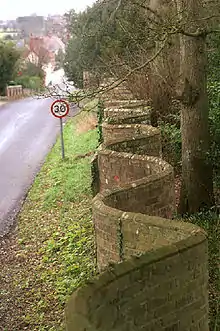Crinkle crankle wall
A crinkle crankle wall, also known as a crinkum crankum, serpentine, ribbon or wavy wall, is an unusual type of garden wall built in a serpentine shape with alternating curves, typically found in the United Kingdom.[1]

The alternate convex and concave curves in the wall provide stability and help it to resist lateral forces,[2] leading to greater strength than a straight wall of the same thickness of bricks without the need for buttresses.
The phrase "crinkle crankle" is an ablaut reduplication, defined as something with bends and turns, first attested in 1598[3] (though "crinkle" and "crankle" have somewhat longer histories).[4][5] However, it was not until the 18th century that the term began to be applied to wavy walls. At that time these garden walls were usually aligned east-west, so that one side faced south to catch the warming sun. They were used for growing fruit.[2][6]
Many crinkle crankle walls are found in East Anglia, England, where the marshes of The Fens were drained by Dutch engineers starting in the mid-1600s. The construction of these walls has been attributed to these engineers, who called them slangenmuur (nl), meaning snake wall.[7] The county of Suffolk claims at least 50 examples, twice as many as in the whole of the rest of the country. The term "crinkle crankle" is said to derive from a Suffolk dialect. The crinkle crankle wall running from the former manor house to All Saints' Church in the estate village of Easton is believed to be the longest existing example.[1][8] In Lymington, Hampshire, there are at least two examples of crinkle crankle walls. The older of the two is thought to have been constructed at the time of the Napoleonic Wars (1803–1815) by exiled Hanoverian soldiers living in the adjacent house.[9]
As a minor part of a larger system of fortification, such a wall may have been used to force oncoming troops to break ranks from closed to open ranks, and further expose them to defensive assault.
Thomas Jefferson (1743–1826) incorporated serpentine walls into the architecture of the University of Virginia, which he founded. Flanking both sides of its landmark rotunda and extending down the length of the lawn are ten pavilions, each with its own walled garden separated by crinkle crankle walls. Although some authorities claim that Jefferson invented this design, he was merely adapting a well-established English style of construction. A university document in his own hand shows how he calculated the savings and combined aesthetics with utility.[10]
References
| Wikimedia Commons has media related to Serpentine walls. |
- Trevor James (2009-10-01). "Out and about looking at Crinkle Crankle Walls". The Historical Association. Retrieved 2020-06-04.
- "Glossary – Terms: crinkle-crankle wall". Park & Gardens UK. Parks and Gardens Data Services Ltd. Archived from the original on 8 September 2012. Retrieved 24 March 2012.
- "crinkle-crankle". Merriam-Webster.com. Merriam-Webster. Retrieved 18 November 2019.
- "crinkle". Merriam-Webster.com. Merriam-Webster. Retrieved 18 November 2019.
- "crankle". Merriam-Webster.com. Merriam-Webster. Retrieved 18 November 2019.
- Curl, James Stevens. Dictionary of Architecture and Landscape Architecture.
- Cambridgeshire County Council (3 November 2011). "Bricklaying apprentices lay a Crinkle-Crankle wall". ShapeYourPlace.org. Archived from the original on 7 July 2012. Retrieved 24 March 2012.
- "Easton crinkle-crackle wall damage a 'real loss'". BBC News. 18 November 2013. Retrieved 15 April 2019.
- "A walk about Lymington". 5 March 2012. Archived from the original on 25 June 2016. Retrieved 15 April 2019.
- Jefferson, Thomas. "Jefferson drawing for the serpentine walls". search.lib.virginia.edu. Retrieved 2019-11-18.